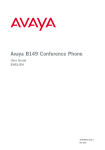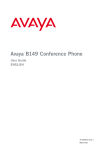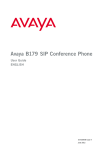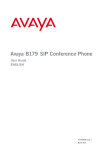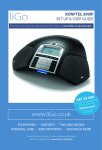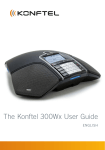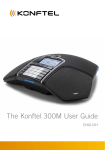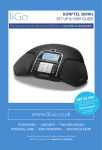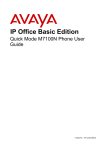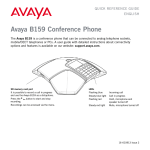Download Avaya B159 User Guide
Transcript
Avaya B159 Conference Phone User Guide ENGLISH 16-603914 Issue 4 Dec 2011 Avaya B159 Conference Phone User Guide © 2011 Avaya Inc. All Rights Reserved. Notice While reasonable efforts have been made to ensure that the information in this document is complete and accurate at the time of printing, Avaya assumes no liability for any errors. Avaya reserves the right to make changes and corrections to the information in this document without the obligation to notify any person or organization of such changes. Documentation disclaimer Avaya shall not be responsible for any modifications, additions, or deletions to the original published version of this documentation unless such modifications, additions, or deletions were performed by Avaya. End User agree to indemnify and hold harmless Avaya, Avaya’s agents, servants and employees against all claims, lawsuits, demands and judgments arising out of, or in connection with, subsequent modifications, additions or deletions to this documentation, to the extent made by End User. Link disclaimer Avaya is not responsible for the contents or reliability of any linked Web sites referenced within this site or documentation(s) provided by Avaya. Avaya is not responsible for the accuracy of any information, statement or content provided on these sites and does not necessarily endorse the products, services, or information described or offered within them. Avaya does not guarantee that these links will work all the time and has no control over the availability of the linked pages. Warranty Avaya provides a limited warranty on this product. Refer to your sales agreement to establish the terms of the limited warranty. In addition, Avaya’s standard warranty language, as well as information regarding support for this product, while under warranty, is available to Avaya customers and other parties through the Avaya Support Web site: http:/www.avaya.com/support. Please note that if you acquired the product from an authorized Avaya reseller outside of the United States and Canada, the warranty is provided to you by said Avaya reseller and not by Avaya. Licenses THE SOFTWARE LICENSE TERMS AVAILABLE ON THE AVAYA WEBSITE, HTTP://SUPPORT.AVAYA.COM/ LICENSEINFO/ ARE APPLICABLE TO ANYONE WHO DOWNLOADS, USES AND/OR INSTALLS AVAYA SOFTWARE, PURCHASED FROM AVAYA INC., ANY AVAYA AFFILIATE, OR AN AUTHORIZED AVAYA RESELLER (AS APPLICABLE) UNDER A COMMERCIAL AGREEMENT WITH AVAYA OR AN AUTHORIZED AVAYA RESELLER. UNLESS OTHERWISE AGREED TO BY AVAYA IN WRITING, AVAYA DOES NOT EXTEND THIS LICENSE IF THE SOFTWARE WAS OBTAINED FROM ANYONE OTHER THAN AVAYA, AN AVAYA AFFILIATE OR AN AVAYA AUTHORIZED RESELLER, AND AVAYA RESERVES THE RIGHT TO TAKE LEGAL ACTION AGAINST YOU AND ANYONE ELSE USING OR SELLING THE SOFTWARE WITHOUT A LICENSE. BY INSTALLING, DOWNLOADING OR USING THE SOFTWARE, OR AUTHORIZING OTHERS TO DO SO, YOU, ON BEHALF OF YOURSELF AND THE ENTITY FOR WHOM YOU ARE INSTALLING, DOWNLOADING OR USING THE SOFTWARE (HEREINAFTER REFERRED TO INTERCHANGEABLY AS “YOU” AND “END USER”), AGREE TO THESE TERMS AND CONDITIONS AND CREATE A BINDING CONTRACT BETWEEN YOU AND AVAYA INC. OR THE APPLICABLE AVAYA AFFILIATE (“AVAYA”). Avaya grants End User a license within the scope of the license types described below. The applicable number of licenses and units of capacity for which the license is granted will be one (1), unless a different number of licenses or units of capacity is specified in the Documentation or other materials available to End User. “Designated Processor” means a single stand-alone computing device. “Server” means a Designated Processor that hosts a software application to be accessed by multiple users. “Software” means the computer programs in object code, originally licensed by Avaya and ultimately utilized by End User, whether as stand-alone products or pre-installed on Hardware. “Hardware” means the standard hardware originally sold by Avaya and ultimately utilized by End User. License types Concurrent User License (CU). End User may install and use the Software on multiple Designated Processors or one or more Servers, so long as only the licensed number of Units are accessing and using 2 Avaya B159 Conference Phone User Guide the Software at any given time. A “Unit” means the unit on which Avaya, at its sole discretion, bases the pricing of its licenses and can be, without limitation, an agent, port or user, an e-mail or voice mail account in the name of a person or corporate function (e.g., webmaster or helpdesk), or a directory entry in the administrative database utilized by the Software that permits one user to interface with the Software. Units may be linked to a specific, identified Server. CPU License (CP). End User may install and use each copy of the Software on a number of Servers up to the number indicated by Avaya provided that the performance capacity of the Server(s) does not exceed the performance capacity specified for the Software. End User may not re-install or operate the Software on Server(s) with a larger performance capacity without Avaya’s prior consent and payment of an upgrade fee Copyright Except where expressly stated otherwise, no use should be made of materials on this site, the Documentation(s) and Product(s) provided by Avaya. All content on this site, the documentation(s) and the product(s) provided by Avaya including the selection, arrangement and design of the content is owned either by Avaya or its licensors and is protected by copyright and other intellectual property laws including the sui generis rights relating to the protection of databases. You may not modify, copy, reproduce, republish, upload, post, transmit or distribute in any way any content, in whole or in part, including any code and software. Unauthorized reproduction, transmission, dissemination, storage, and or use without the express written consent of Avaya can be a criminal, as well as a civil, offense under the applicable law. Third-party components Certain software programs or portions thereof included in the Product may contain software distributed under third party agreements (“Third Party Components”), which may contain terms that expand or limit rights to use certain portions of the Product (“Third Party Terms”). Information regarding distributed Linux OS source code (for those Products that have distributed the Linux OS source code), and identifying the copyright holders of the Third Party Components and the Third Party Terms that apply to them is available on the Avaya Support Web site: http://www.avaya.com/support/Copyright/. Preventing toll fraud “Toll fraud” is the unauthorized use of your telecommunications system by an unauthorized party (for example, a person who is not a corporate employee, agent, subcontractor, or is not working on your company’s behalf). Be aware that there can be a risk of toll fraud associated with your system and that, if toll fraud occurs, it can result in substantial additional charges for your telecommunications services. Avaya fraud intervention If you suspect that you are being victimized by toll fraud and you need technical assistance or support, call Technical Service Center Toll Fraud Intervention Hotline at +1-800-643-2353 for the United States and Canada. For additional support telephone numbers, see the Avaya Support Web site: http://www.avaya.com/ support/. Suspected security vulnerabilities with Avaya products should be reported to Avaya by sending mail to: [email protected]. Trademarks The trademarks, logos and service marks (“Marks”) displayed in this site, the documentation(s) and product(s) provided by Avaya are the parties. Users are not permitted to use such Marks without prior written consent from Avaya or such third party which may own the Mark. Nothing contained in this site, the documentation(s) and product(s) should be construed as granting, by implication, estoppel, or otherwise, any license or right in and to the Marks without the express written permission of Avaya or the applicable third party. Avaya is a registered trademark of Avaya Inc. All other trademarks are the property of their respective owners. Downloading documents For the most current versions of documentation, see the Avaya Support Web site: http://www.avaya.com/ support Contact Avaya Support Avaya provides a telephone number for you to use to report problems or to ask questions about your product. The support telephone number is 1-800-242-2121 in the United States. For additional support telephone numbers, see the Avaya Web site: http://www.avaya.com/support 3 Avaya B159 Conference Phone User Guide The patented audio technology OmniSound® 2.0 provides impressive audio quality for your distance meetings. Full-duplex audio via the hypersensitive microphone and powerful speakers enables speech in both directions. This natural loudspeaker sound quality is critical for effective, collaborative meetings that keep everyone engaged and contributing. OmniSound 2.0® is also enhanced with innovative features: noise suppression minimizes distracting background noise, wideband voice transmission provides a 7 kHz frequency range during VoIP calls, and an equalizer allows you to adjust the sound to suit the room’s acoustics. Warning! Do not expose the Avaya B159 to rain or moisture. Warning! Do not open the case on the Avaya B159. Warning! D Only use the power adapter provided to connect the unit to the mains. Avaya B159 Conference Phone User Guide TABLE OF CONTENTS Description2 General................................................... 2 Maintenance........................................... 2 keypad................................................... 4 Navigation and selection in menus............ 5 Ending a recording..................................19 Listening to a recording.......................... 20 Managing recordings...............................21 Adjusting the recording indicator..............21 Displaying recording feature status...........21 Connections6 Settings22 Unpacking.............................................. 6 Connecting and installing......................... 6 Select region and language....................... 6 Connectivity options................................. 7 Selecting languages............................... 22 Select region......................................... 22 Deactivating keypad tones...................... 22 Adjusting date and time......................... 22 Adjusting ring level volume..................... 23 Adjusting the flash/R pulse duration ....... 23 Selecting Caller ID standard................... 23 Adjusting microphone volume with mobile phone connected.........................24 Adjusting sound (equalizer)......................24 Settings for connecting external equipment (Aux).....................................24 Settings for external PA system................24 Changing text on the display screen......... 25 Adjusting LCD contrast........................... 25 Resetting.............................................. 25 Checking status..................................... 25 Settings during a call............................. 26 Answering and making calls 8 Answering calls....................................... 8 Ending calls............................................ 8 Making calls............................................ 8 Making three-way calls on an analog line.... 9 VoIP calls................................................ 9 Calls via DECT and mobile phones............10 During a call 11 Adjusting the speaker volume...................11 Placing calls on temporary hold................11 Ending calls...........................................11 Switching lines during calls......................12 Conference guide 13 Creating conference groups.....................13 Making conference group calls.................13 Making multi-party calls..........................14 Displaying conference group participants..14 Editing conference groups.......................14 Deleting conference groups......................15 Delete all conference groups....................15 Conference guide settings.......................15 Displaying conference guide status...........16 Upgrading software 27 Installing Avaya Upgrade Utility............... 27 Upgrading software................................ 27 Technical specifications 28 Phonebook17 Searching for contacts............................17 Adding contacts.....................................17 Editing contacts.....................................17 Deleting contacts....................................18 Deleting all conference groups.................18 Displaying phonebook status....................18 Recording19 Starting a recording................................19 Mute function.........................................19 Hold......................................................19 1 Avaya B159 Conference Phone User Guide DESCRIPTION GENERAL The Avaya B159 conference phone offers a host of innovative features: • OmniSound® audio technology. • USB connectivity allows the phone to be used to make VoIP calls. • The line mode enables you to combine and switch easily between connectivity technologies – analog, USB, mobile (GSM/DECT). • Conference guide for easy set-up of multiparty calls. • Record your meetings with an SD memory card so that you can listen to them later on. • Expansion microphones can be added to increase the voice pickup range. (Optional.) • A wireless headset or PA system can be connected. (Optional.) • Can be upgraded with smart features, making it future-proof. The Avaya B159 is a future-proof product that is constantly evolving with smart new features. MAINTENANCE Clean the equipment with a soft, dry cloth. Never use liquids. 2 Avaya B159 Conference Phone User Guide DESCRIPTION Speaker Microphone Display screen Keypad LEDs SD memory card port LEDs Flashing blue Incoming call Steady blue light Call in progress Flashing red Hold, microphone and speaker turned off Steady red light Mute, microphone turned off Expansion microphone port Mobile/DECT phone connection Analog line connection AUX port Mini USB port for PC connection Expansion microphone port Security lock port Power supply port 3 Avaya B159 Conference Phone User Guide DESCRIPTION KEYPAD UP ARROW Navigation in menus Display of call list Menu Settings DOWN ARROW Navigation in menus Display of call list OK Yes/confirm choice Cancel No/end/back Start/ stop recording Answer/connect calls and Flash During a call: Press to call a new person Increase volume Decrease volume Hang up/end call Conference Automatic dialling of conference groups Mute Alphanumerical buttons Hold down a button for 2 seconds to open the phonebook Hold One press of this button will always connect all parties to a conference call Line mode Connectivity options Some Avaya B179 have a different keypad with other symbols. This does not affect the functions of the buttons. Writing text Each button contains letters and characters – more than those shown on the button (see illustration below). Press the same button repeatedly to change to another character. If there are two letters under the same button that you want to enter one after the other, you need to pause slightly before entering the second letter. Press the button to delete the last character you entered. (space) . - 1 A B C Å Ä Á À 2 D E F É È 3 G H I 4 J K L 5 M N O Ö Ø Ñ 6 P Q R S 7 T U V Ü Ú 8 W X Y Z 9 0 4 Avaya B159 Conference Phone User Guide DESCRIPTION NAVIGATION AND SELECTION IN MENUS Press . Select the option you want from the menu using the arrow buttons. Confirm by pressing OK to select the marked option. Cancel the setting or go back one level in the menu by pressing . Quit the menu by pressing again. Note that after you have made changes to a setting, you must press OK to activate the setting. Writing style in instructions In the instructions, > SETTINGS means you should: Press . Mark the SETTINGS option using the arrow buttons and confirm by pressing OK to open the menu. Menu tree PHONE BOOK SETTINGS CONF GUIDE RECORDING SEARCH CONTACT LANGUAGE SEARCH GROUP PLAYBACK FILE ADD CONTACT REGION SHOW GROUP RENAME FILE EDIT CONTACT KEY TONE ADD GROUP DELETE FILE ERASE CONTACT TIME DATE EDIT GROUP DELETE ALL ERASE ALL RING LEVEL ERASE GROUP SETTINGS STATUS STATUS FLASH ERASE ALL CALLER ID SETTINGS MOBILE LEVEL STATUS STATUS EQUALIZER AUX PORT PA SCREEN TEXT LCD CONTRAST DEFAULT 5 Avaya B159 Conference Phone User Guide CONNECTIONS UNPACKING Check that all parts are included in the package. If any parts are missing, please contact your retailer. • • • • • • The Avaya B159 conference phone Power adapter with universal socket compatibility 7.5 metre cable for electric power and line connection 1.5 metre USB cable Intermediate plugs for analog connection Quick reference guides in different languages CONNECTING AND INSTALLING Connect to an analog line, wireless DECT telephone/mobile phone or PC as illustrated. An optional phone cable is required for connection to DECT/mobile phones. Plug the Avaya B159 into the mains using the power adapter as illustrated. Place the conference phone in the middle of the table. SELECT REGION AND LANGUAGE The first time the Avaya B159 is started, you will be required to select the region in which you are located. The Avaya B159 then automatically configures to the telecom network for that region. Select the region in which you are located. Click OK to confirm your selection. You can use the arrow buttons to press an alphanumeric button to jump to the first region that starts with that letter in the list. 6 Avaya B159 Conference Phone User Guide CONNECTIONS Select the language you want. Click OK to confirm your selection. Select > SETTINGS if you want to set the date and time or make other adjustments. CONNECTIVITY OPTIONS An analog phone line is the pre-programmed option, but it is possible to switch between and combine two connectivity options. Press the key. Use the arrow buttons to select a connectivity option and press OK to confirm your choice. Options Connections: • Analog telephone line • Mobile/DECT telephone • Computer (VoIP) • Analog telephone line+computer • Mobile/DECT telephone+computer The display screen shows: ANALOGUE MOBILE USB ANALOGUE+USB MOBILE+USB Please turn to page 9 for instructions on using the Avaya B159 with a computer and a mobile/DECT telephone. Connection to a PC You can hold group calls over the Internet using VoIP software (e.g. Skype®) with the Avaya B159. The Avaya B159 acts as a loudspeaker and microphone when making VoIP calls. In stand-by mode , it can also be used to play audio and music. When the Avaya B159 is in stand-by mode, the display screen shows that the microphone is turned off. 7 Avaya B159 Conference Phone User Guide ANSWERING AND MAKING CALLS ANSWERING CALLS A ring tone is heard and the blue LEDs start flashing. Press to answer. The LEDs show a steady blue light. The duration of the call is shown on the display screen. ENDING CALLS End the call by pressing . MAKING CALLS Dial the number. Press . The number is called and the LEDs show a steady blue light. The duration of the call is shown on the display screen. Or: Press . Dial the number. The number is called and the LEDs show a steady blue light. The duration of the call is shown on the display screen. Redialling Press an arrow button. The last number that you dialled appears on the display screen. Use the arrow buttons to look through previously dialled numbers. Press . The number you select is dialled. Calling from the phonebook Please turn to page 17 for instructions on adding and updating contacts in the phonebook. Press and hold down a number button for two seconds. The phonebook appears on the display screen. The pre-programmed names appear in alphabetical order, starting with the number button’s first letter. Use the arrow buttons to look through the phonebook. Press . The contact you select is dialled. 8 Avaya B159 Conference Phone User Guide ANSWERING AND MAKING CALLS MAKING THREE-WAY CALLS ON AN ANALOG LINE The simplest way to set up a multi-party call is to use the conference guide (see page 13). You can connect another party to an on-going call as follows. During a call, the button acts as R-pulse (flash), which means it transmits commands to the PBX. If you experience problems making multi-party calls: Please contact your telephone administrator. Turn to page 23 for more details. Press (F). A second dialling tone is heard. Dial the second participant’s number and wait for an answer. Press the (F) button and then 3. All three participants are now linked together in one call. It is also possible to connect the lines by pressing the button, provided the settings for the Conference guide are correct, see page 15. If you don’t get an answer when you dial the second number Go back to the first call by pressing (F). VOIP CALLS For these instructions, it is assumed that the computer is turned on, the VoIP software (e.g. Skype®) is running and the Avaya B159 is connected to the computer via the USB cable. Line mode Press and select USB as a phone line using the arrow buttons. Press OK to confirm. Connecting two lines MOBILE+USB connects calls via mobile telephones with VoIP calls over the Internet. ANALOGUE+USB connects calls on analog lines with VoIP calls over the Internet. Making VoIP calls Press . The Avaya B159 has now been put into call mode and the LEDs show a steady blue light. Indicate whether you want to connect a call with one user or several users in the computer’s VoIP software. The Avaya B159 functions as a speaker and microphone for the computer. 9 Avaya B159 Conference Phone User Guide ANSWERING AND MAKING CALLS Answering a VoIP call Press . The Avaya B159 has now been put into call mode and the LEDs show a steady blue light. Indicate whether you want to start the call by answering in the computer’s VoIP software. The Avaya B159 functions as a speaker and microphone for the computer. Ending a VoIP call End the call in the computer’s VoIP software and put the Avaya B159 on stand-by by pressing . The Avaya B159 now only functions as a speaker for the computer. CALLS VIA DECT AND MOBILE PHONES For these instructions, it is assumed that the Avaya B159 is connected to a DECT or mobile telephone via a cable (optional accessory). Hereafter, both types of telephone are referred to as mobile phones. Select mobile as the telephone line Press and use the arrow buttons to select MOBILE as a phone line. Press OK to confirm. If you select MOBILE+USB as the line mode in the Avaya B159, you will be able to combine the call with a call connected via the computer (see page 9). Making calls using a mobile phone Press and dial the number on the mobile phone as you normally would. The Avaya B159 now functions as a speaker and microphone for the mobile phone. The LEDs show a steady blue light. Ending calls Ending the call on the mobile phone. Press to turn off the Avaya B159. 10 Avaya B159 Conference Phone User Guide DURING A CALL ADJUSTING THE SPEAKER VOLUME Adjust the speaker volume using the buttons and . Adjusting the speaker volume when two lines are connected If you have selected double lines, you can adjust the volume level for each line. This is useful if the lines have different volume levels. Press the button or the button to display the current volume setting. The current main volume appears on the display screen. Above it are two smaller volume indicators which can be used to adjust the two connection lines. Increase or decrease the speaker volume for both lines in the normal way, using the and buttons. Use the arrow buttons to mark either of the connected lines. and Select a line and adjust its speaker volume using the buttons. PLACING CALLS ON TEMPORARY HOLD Mute Press to turn off the microphone. The LEDs change from blue to red. The other party cannot hear what you are saying. Press to reconnect the call. Hold Press to put the call on hold. The LEDs change from blue to flashing red. Both the microphone and the speaker are turned off and the call is on hold. Press to reconnect the call. ENDING CALLS End the call by pressing . 11 Avaya B159 Conference Phone User Guide DURING A CALL SWITCHING LINES DURING CALLS Connecting a new line during a call You can add another line or switch between connected lines during a call. Press the button during the call. An indicator appears on the display screen in front of the selected line(s). Use the arrow buttons to mark the line you want to connect and confirm your choice by pressing . If you selected USB or MOBILE, this line will open. You then connect the call via the computer or mobile phone. If you selected ANALOGUE, you will hear a dialling tone. You then dial the number on the Avaya B159 or use the Phonebook. Please note that an analog line and a mobile line cannot be used simultaneously. If you are using ANALOGUE or ANALOGUE+USB as a line connection and you wish to connect MOBILE during a call, the ANALOGUE line will be put on hold. This is indicated by a flashing LED on the display screen. Putting a line on hold during a call Press the button during the call. Use the arrow buttons to mark the line you want to put on hold and press the button. The indicator in front of the selected line starts to flash. Repeat the above to reconnect the line. Disconnecting a line during a call Press the button during the call. Use the arrow buttons to mark the line you want to disconnect and confirm your choice by pressing . The indicator in front of the selected line goes out and the line is disconnected. The other calls can continue. 12 Avaya B159 Conference Phone User Guide CONFERENCE GUIDE The conference guide allows you to create 20 conference groups with up to six people in each. You can now call the participants in a meeting by simply pressing a few buttons. You may need to adjust some settings in your Avaya B159 to make it compatible with your PBX. Please turn to page 16 in this User Guide for more details. Entering text with the keypad Please turn to page 4 for instructions on using the keypad to enter text. CREATING CONFERENCE GROUPS Select > CONF GUIDE > ADD GROUP. Enter a group name and press OK to confirm. Press OK to enter the first person. Write the name of the first person and press OK to confirm. Enter the number and press OK to confirm. Press OK to add another person and repeat the above steps. Conclude by pressing . MAKING CONFERENCE GROUP CALLS Press the button. Select the conference group you want to call. The Avaya B159 dials the first person and asks you to confirm when the person answers. Press OK when the first person has answered. Continue in the same way for each person in the group. If you don’t get an answer Press if one of the persons you are trying to call does not answer. The conference guide will ask you if you want to redial that person. Either press OK or . If you decide not to redial ( continue to the next person. Press OK to continue and ) you will be asked if you want to end the conference guide or to end the guide. When the guide has ended, you will be connected with up to six people and ready to start your conference. Please note that you can also call a conference group via SEARCH GROUP in the CONF GUIDE menu. 13 Avaya B159 Conference Phone User Guide CONFERENCE GUIDE MAKING MULTI-PARTY CALLS Press the button. Select QUICK GUIDE with the arrow buttons. Press OK to confirm. The Quick Guide asks you to dial the first number. Dial the first person’s telephone number. Press OK to confirm. Press OK when the first person has answered. Press OK to call another person and repeat the above steps. Press when you have called all the persons you want for your meeting. If one of the persons does not answer, follow the steps for calling a saved conference group (see above). DISPLAYING CONFERENCE GROUP PARTICIPANTS Select > CONF GUIDE > SHOW GROUP. Mark the group you want and press OK. The names of the conference group participants are displayed. EDITING CONFERENCE GROUPS Select > CONF GUIDE > EDIT GROUP. Here, you can change the name of a conference group, add or delete a person from a group and change a person’s name and phone number. Mark your choice of option in the menu using the arrow buttons and press OK to confirm. The names of the conference groups are displayed. Mark the group you want to change and press OK to confirm. Mark a person you want to change and press OK to confirm. Make the change and press OK to confirm. Delete a number or a letter in a name by pressing . If you want to cancel the change you are making and leave the name or number as they were, press the CONFERENCE GUIDE menu appears. 14 until Avaya B159 Conference Phone User Guide CONFERENCE GUIDE DELETING CONFERENCE GROUPS Select > CONF GUIDE > ERASE GROUP. Mark the group you want to delete and press OK. Confirm that you really want to delete the group by pressing OK or cancel the deletion of a group by pressing . DELETE ALL CONFERENCE GROUPS Select > CONF GUIDE > ERASE ALL. Confirm that you really want to delete all groups by pressing OK or cancel the deletion of all groups by pressing . CONFERENCE GUIDE SETTINGS When a multi-party call is going to be connected, a special signal (flash or R-pulse) is produced which transmits the command (request, return and conference) to the PBX. It may be necessary to change the type of signal if calls are connected via a PBX. Select > CONF GUIDE > SETTINGS. Enter the command for a request for a new dialling tone and press OK to confirm. (“F” is the default setting.) Enter the command to connect everyone to a multi-party call and press OK to confirm. (“F3” is the default setting.) Enter the command to return to your original call and press OK to confirm. (“F” is the default setting.) If you experience problems making multi-party calls It may be necessary to change the duration of the Flash/R-pulse so that it works with your PBX. Read “ADJUSTING FLASH/R-PULSE DURATION” on page 23. Your PBX may not be programmed to admit multi-party calls or the procedure may be different. Please contact your telephone administrator or service provider. 15 Avaya B159 Conference Phone User Guide CONFERENCE GUIDE DISPLAYING CONFERENCE GUIDE STATUS Select > CONF GUIDE > STATUS. The display screen indicates the number of conference groups already stored plus how many more groups can be added. 16 Avaya B159 Conference Phone User Guide PHONEBOOK The Avaya B159 has a phonebook that holds up to 50 entries. See page 8 for making calls via the phonebook. Entering text with the keypad Please turn to page 4 for instructions on using the keypad to enter text. SEARCHING FOR CONTACTS The simplest way to search for a contact in the address book is to hold down a number button for two seconds (see page 8). You can also search for a contact via the PHONEBOOK menu. Select > PHONE BOOK > SEARCH CONTACT. Mark the contact you want. You can use the arrow buttons to press an alphanumeric button to jump to the first name that starts with that letter in the list. Press OK or or to dial the selected contact, to exit the menu. to return to the PHONEBOOK menu ADDING CONTACTS Select > PHONE BOOK > ADD CONTACT. Enter the name of the contact and press OK to confirm. Write the number and press OK to confirm. Press OK to add another contact or to exit the menu. EDITING CONTACTS Select > PHONE BOOK > EDIT CONTACT. Mark the contact you want to change. Press OK to confirm. Make the change and press OK to confirm. Delete a number or a letter in a name by pressing . If you want to cancel the change you are making and leave the name or number as they were, press the PHONEBOOK menu appears. until 17 Avaya B159 Conference Phone User Guide PHONEBOOK DELETING CONTACTS Select > PHONE BOOK > ERASE CONTACT. Mark the contact you want to delete and press OK. Confirm that you really want to delete the contact by pressing OK or cancel the deletion of a contact by pressing . DELETING ALL CONFERENCE GROUPS Select > PHONE BOOK > ERASE ALL. Confirm that you really want to delete all contacts by pressing OK or cancel the deletion of a contact by pressing . DISPLAYING PHONEBOOK STATUS Select > PHONE BOOK > STATUS. The display screen indicates the number of contacts already stored plus how many more contacts can be added. 18 Avaya B159 Conference Phone User Guide RECORDING It is possible to record a phone conference on an SD (Secure Digital) memory card so you can listen to it later on. A flashing symbol appears on the display screen during recording. A beep is heard every 20 seconds so that other parties in the call know it is being recorded. The beep can be turned off (see page 21). The recorded call is saved on the memory card. The document is named after the time at which the recording began (e.g. 14-35-01.wav) and is saved in a folder with the current date. This name can be changed after the recording has ended (see page 21). STARTING A RECORDING Remember to notify all parties in the call before you start recording. Press the button for two seconds and press OK to confirm. The recording symbol flashes on the display screen. MUTE FUNCTION Press the button during a call to turn the microphone off. The LEDs change from blue to red. The other party cannot hear what you are saying and only the called party is recorded. HOLD Press during the call to put the call on hold. The LEDs change from blue to flashing red. Both the microphone and the speaker are turned off and the call is on hold. None of the parties will now be recorded. ENDING A RECORDING Press the button for two seconds and press OK to confirm. The recording symbol is no longer displayed on the screen. 19 Avaya B159 Conference Phone User Guide RECORDING LISTENING TO A RECORDING You can listen to a recorded phone conference on your Avaya B159 or a computer using an SD memory card reader. Recordings are saved in .wav format and can be played back on your choice of media player. Listening to recordings on the Avaya B159: Select > RECORDING > PLAYBACK FILE. Mark the folder you want (date) and press OK to confirm. A list of all recordings for the specified date is displayed. Names, date, time and length are displayed for each recording. Mark the recording you want and start the playback by pressing OK. Adjusting the speaker volume Increase the volume using the button and lower it using . Pause playback Pause the playback by pressing OK. Restart playback by pressing OK again. Move forward in the recording during playback Move forward in the recording by pressing arrow down or backward by pressing arrow up. The recording advances about 10 seconds every time you press the button. You can also jump further forward in the recording: Key Key Key Key 3 6 1 4 – – – – forward 1 minute forward 10 minutes backward 1 minute backward 10 minutes Stop playback Stop the playback by pressing 20 . Avaya B159 Conference Phone User Guide RECORDING MANAGING RECORDINGS Editing the name of a recording The recording is named by default with the time at which the recording started. Select > RECORDING > RENAME FILE. Mark the folder you want and press OK to confirm. Mark the recording to be edited and press OK. Make the change and press OK to confirm. Delete a number or a letter in a name by pressing . If you want to cancel the change you are making and leave the name or number as they were, press several times until the RECORDING menu appears. Deleting a recording Select > RECORDING > DELETE FILE. Mark the folder you want and press OK. Mark the recording to be deleted and press OK. Confirm that you really want to delete the recording by pressing OK again, or cancel the deletion of a recording by pressing . Deleting all recordings Select > RECORDING > DELETE ALL. Confirm that you really want to delete all recordings by pressing OK again, or cancel the deletion of a recording by pressing . ADJUSTING THE RECORDING INDICATOR A short beep is heard every 20 seconds so that all the parties in the call know it is being recorded. This feature can be turned off. Select > RECORDING > SETTINGS. Select your choice and press OK to confirm. DISPLAYING RECORDING FEATURE STATUS Select > RECORDING > STATUS. The display screen indicates the number of recordings, the total length of recorded calls and how many hours of recording time are left before the memory card is full. 21 Avaya B159 Conference Phone User Guide SETTINGS SELECTING LANGUAGES Select > SETTINGS > LANGUAGE. Select the language you want and press OK to confirm. SELECT REGION The first time the Avaya B159 is started, you will be required to select the region in which you are located. The Avaya B159 then automatically configures to the telecom network for that region. Your selected entries can be changed later via this menu. Select > SETTINGS > REGION. Select the region in which you are located. DEACTIVATING KEYPAD TONES You can select whether or not you want a tone to be heard when you press a button. Note that this setting does not affect the tone you hear when you dial a number in call mode. Select > SETTINGS > KEY TONE. Select your choice and press OK to confirm. ADJUSTING DATE AND TIME Changing the date Select > SETTINGS > TIME DATE > DATE. Change the flashing figures for the year using the arrow buttons or by entering the figures on the keypad. Press OK to confirm and to continue to the month, and then proceed in the same way for the day. Changing the time Select > SETTINGS > TIME DATE > TIME. Change the flashing figures for the hour using the arrow buttons or by entering the figures on the keypad. Press OK to confirm and to continue to minutes. Changing the time format Select > SETTINGS > TIME DATE > TIME FORMAT. Select either a 12-hour or a 24-hour format using the arrow buttons and press OK to confirm your choice. 22 Avaya B159 Conference Phone User Guide SETTINGS ADJUSTING RING LEVEL VOLUME Select > SETTINGS > RING LEVEL. Select your choice and press OK to confirm. There are six volume levels plus a silent mode. You will hear the ring tone for each level you select. If you select silent mode, an LED on the phone flashes when an incoming call is received. ADJUSTING THE FLASH/R PULSE DURATION The Flash/R pulse (Register recall) is used to request a new line from the PBX. Different countries may require different durations for activating the Flash/R pulse. Select > SETTINGS > FLASH. Select your choice and press OK to confirm. Examples of suitable settings are: 100 ms – Scandinavia, Europe, Siemens HiPath 300 ms – Germany, France, Israel 500 ms – USA SELECTING CALLER ID STANDARD Avaya B159 needs to be configured to match the Caller ID standard in your country. Note that in some cases even individual states/provinces within a country use different standards. The table below is a guideline for choosing the correct setting. If the caller ID is not working properly, select another setting or contact your telephone service provider for further information. Caller ID standard Country Bellcore (Telcordia) Canada (usually), USA, Australia, New Zealand, China, Hong Kong, Singapore ETSI Austria, Belgium, Czech Republic, France, Germany, Italy, Luxemburg, Norway, Poland, Spain, Slovenia, Switzerland, Turkey, South Africa, Taiwan BT (British Telecom) United Kingdom DTMF Denmark, Finland, Greece, Iceland, Netherlands, Portugal, Sweden, China, India, Saudi Arabia, Brazil, Uruguay Select > SETTINGS > CALLER ID. Select your choice and press OK to confirm. 23 Avaya B159 Conference Phone User Guide SETTINGS ADJUSTING MICROPHONE VOLUME WITH MOBILE PHONE CONNECTED The Avaya B159 microphone has seven volume settings, so if the volume of calls via DECT/mobile phones is too soft or too loud, you can easily adjust it to the right level. Select > SETTINGS > MOBILE LEVEL. Select your choice and press OK to confirm. ADJUSTING SOUND (EQUALIZER) The sound reproduction can be adjusted to the required pitch (SOFT, NEUTRAL and BRIGHT). Select > SETTINGS > MOBILE LEVEL. Select your choice and press OK to confirm. SETTINGS FOR CONNECTING EXTERNAL EQUIPMENT (AUX) The Avaya B159 can be connected to a wireless headset or an external PA system. An optional PA interface box is required for PA system connection. Select > SETTINGS > AUX PORT. Select the PA option to activate features for external microphone mixer and PA system. Do not select the PA option unless a PA system is connected. This option turns off the internal microphone and internal speakers. The HEADSET option may be selected whether or not a headset is connected. SETTINGS FOR EXTERNAL PA SYSTEM It is assumed that the PA option has been activated in the previous menu before making these settings. Select > SETTINGS > PA. Select INTERNAL MIC and press OK to switch between on (shaded box) and off. To ensure maximum audio quality, do not use the internal microphone and external microphones connected via the PA interface box at the same time. Only the internal microphone is turned off. Any external microphones connected to the Avaya B159 are still turned on. Select INTERNAL SPKR and press OK to switch between on (shaded box) and off. 24 Avaya B159 Conference Phone User Guide SETTINGS To ensure maximum audio quality, do not use the internal speakers and external speakers connected via the PA interface box at the same time. CHANGING TEXT ON THE DISPLAY SCREEN The text on the display screen can be changed when the Avaya B159 is on hook. Select > SETTINGS > SCREEN TEXT. and enter your new text. Press OK to confirm. Delete existing text using ADJUSTING LCD CONTRAST Select > SETTINGS > LCD CONTRAST. Select your choice and press OK to confirm. RESETTING There is a menu option under SETTINGS that resets all settings to default. Please note that this also deletes all contacts in the phonebook and all groups saved in the conference guide. Select > SETTINGS > DEFAULT. Confirm that you really want to reset the settings to default by pressing OK again, or cancel the resetting procedure by pressing . CHECKING STATUS If you need to check the software version or serial number. Select > STATUS. 25 Avaya B159 Conference Phone User Guide SETTINGS SETTINGS DURING A CALL The HEADSET/PA, PHONE BOOK, MOBILE LEVEL and EQUALIZER menus may be accessed during a call and are displayed when the button is pressed. The first option is either HEADSET or PA depending on whether PA is activated or not. These HEADSET/PA settings can only be accessed when a call is connected. Turn off the internal speakers when using a headset PA should not be activated when using the HEADSET menu option. A wireless headset can be used if a person needs to move far away from the conference phone (e.g. during a seminar or presentation). The internal speakers can be turned off temporarily if you wish to use the Avaya B159 as a personal telephone with a headset. Select > HEADSET. Select YES when asked “SPEAKER OFF?”. The speakers come on automatically when the call is ended. Adjusting PA calibration manually It is possible to calibrate the duplex performance of the conference phone when it is connected to a PA system. The calibration level can be set automatically by the Avaya B159 or adjusted manually to any value between 0 and 5 (0 being full duplex). • Increase the calibration if the remote party experiences disturbing echoes. • Decrease the calibration if the remote party experiences low duplex, i.e. your voice is muted or clipped when the other party is speaking. The position of the PA system’s microphones and speakers and the amplifier’s settings may affect full duplex performance. Select > PA > CALIBRATION. AUTO is the default setting and is recommended in most cases. The figure shown in brackets is the measured calibration value. Select different levels and compare the audio quality to achieve your preferred setting. NB. You must ask the person you are calling to assess the effect of the adjustments you make. Adjusting microphone volume from PA system PA should be activated when using the PA menu option. Select > PA > PA MONITOR. Adjust the microphone volume from the mixer so that the level on the display screen is around 10–12 when speaking in a normal tone. 26 Avaya B159 Conference Phone User Guide UPGRADING SOFTWARE The Avaya B159 is continually being developed with smart features. You will first need to install Avaya Upgrade Utility on your computer before you can upgrade your Avaya B159. Find out more at www.avaya.com/support. INSTALLING AVAYA UPGRADE UTILITY Go to the website www.avaya.com/support. Select “Downloads” from the menu on the left side. Enter “Conference Phones”. Download the Avaya Upgrade Utility. Install the software on your computer. Follow the instructions given by the installation program. UPGRADING SOFTWARE Start the Avaya Upgrade Utility software on your computer from the Start menu. Follow the instructions that the software guide gives you. 27 Avaya B159 Conference Phone User Guide TECHNICAL SPECIFICATIONS Size Diameter 240 mm, height 77 mm Weight 1 kg Color Charcoal black Display screen Illuminated graphics (LCD), 128x64 Keypad Alphanumerical 0–9, *, off hook/F, on hook, mute, hold, volume up, volume down, 5 buttons for menu navigation, line mode, conference guide Anti-theft protection Kensington security slot Memory Support for SD memory cards up to 2 GB Upgrades Via the USB connection Connectivity Analog telephone connectivity Modular 6/6 modular (RJ11) to an analog PBX PC connectivity USB 2.0 Mini B Audio connectivity for mobile phone 6/6 DEC Power supply AC adapter 100–240 V AC/14 V DC Expansion microphones 2 modular 4/4 Auxiliary Modular 4/4 Audio TechnologyOmniSound® 2.0 Wideband 28 Microphone Omni-directional Reception area Up to 30 metres2, >10 people Speakers Frequency band 200–3300 Hz, analog line 200–7000 Hz, USB VoIP 150–15000 Hz, USB playback Sound level 90 dB SPL 0.5 m Equalizer Three pitches: soft, neutral, bright Avaya B159 Conference Phone User Guide TECHNICAL SPECIFICATIONS Environment Temperature5°–40°C Relative humidity 20–80% condensation free Recommended acoustic conditions Reverberation period: 0.5 S Rt 60 Background noise: 45 dBA Approvals Telecommunication TBR21, 47 CFR Part 68/TIA, IC CS-03 Issue 1999/01/01 EMC EN301 489-1,3. EN 300 220-1,2, FCC subparts B and C Electrical safety UL 60950-1, EN 60950-1:2001 29 110214-61-001 Rev 4A



































